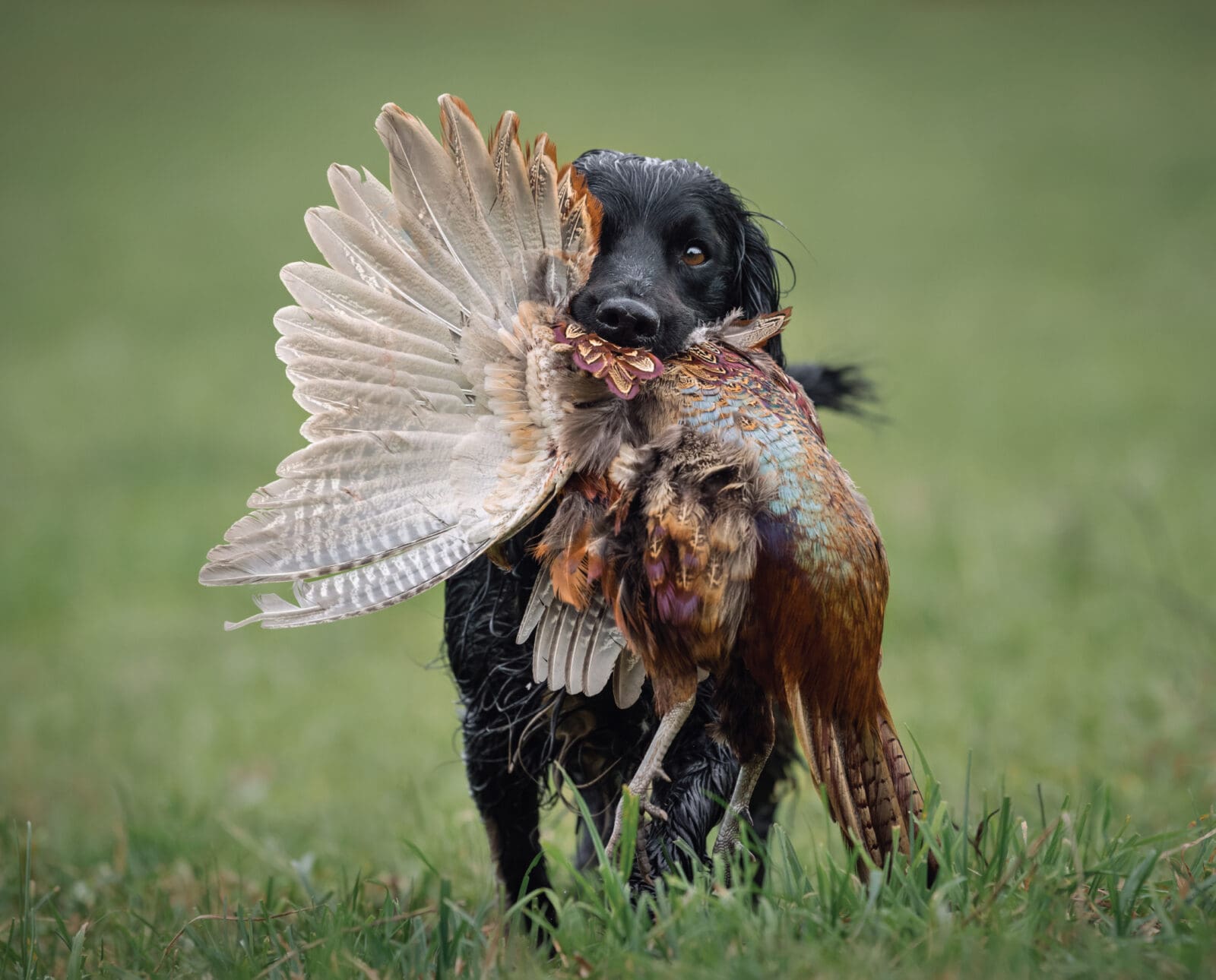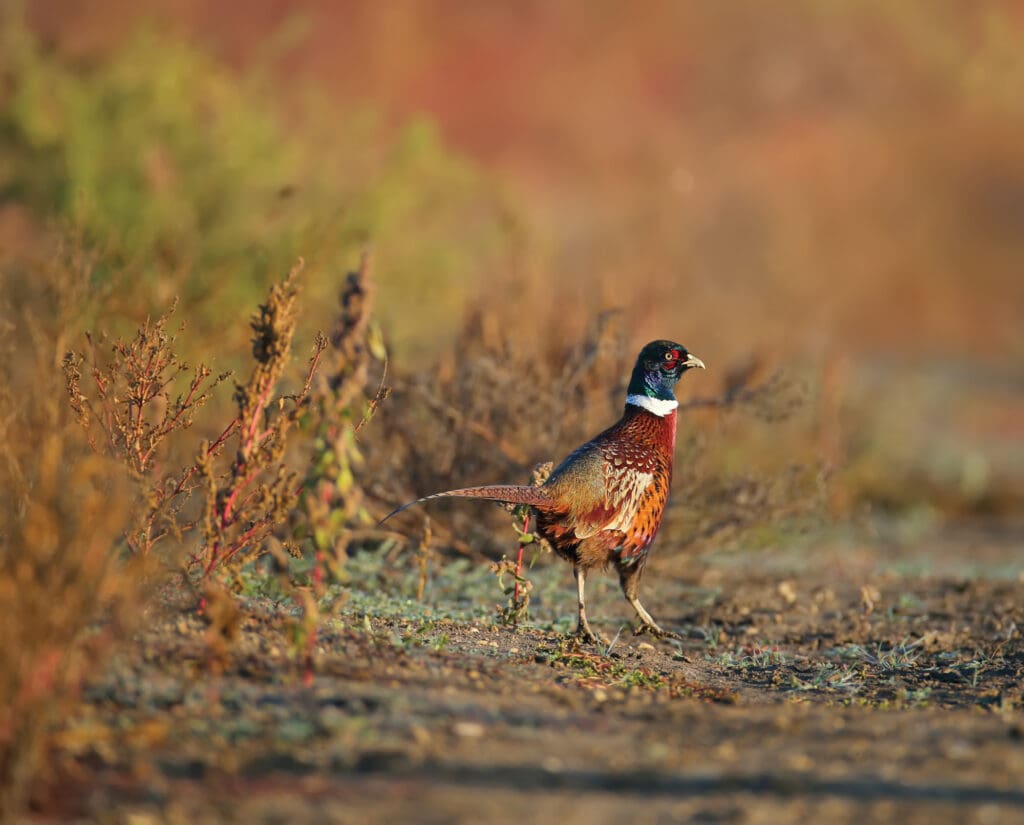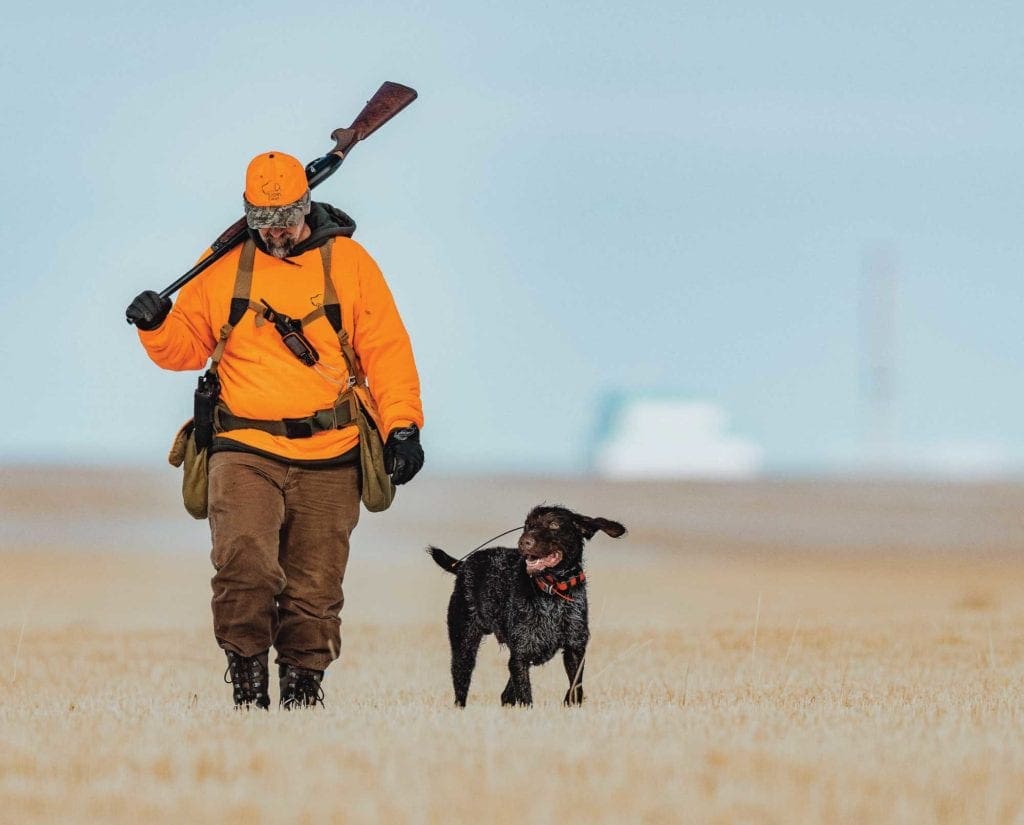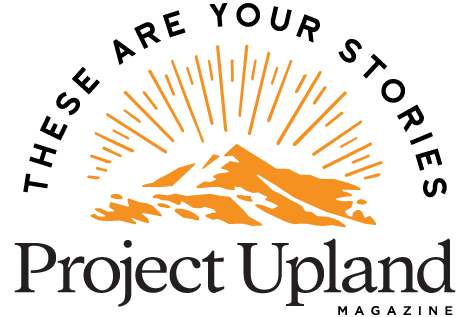Home » Pheasant Hunting » Tips on Hunting Pheasant with a Dog
Tips on Hunting Pheasant with a Dog

Raised in the upland bird mecca of Kansas, the passion…
Handling, reading, and trusting your dog go a long way in improving your odds during this season when hunting pheasants.
Each fall, pheasants draw attention from hunters across the country. Their parrot-like colors strike awe in any bird hunter. Thousands of these beautiful birds are harvested during the first few days of the season. Most birds packed out during opening weekend are young birds born months before the orange army started marching.
Listen to more articles on Apple | Google | Spotify | Audible
There are two reasons young birds represent the bulk of the early harvest. First, juveniles dominate the overall population. Like most upland game birds, pheasants rely on annual production to sustain the population. It’s not unusual for juveniles to comprise up to 80 percent of the population after a summer of good nesting and brood-rearing success. Second, young pheasants are typically not as wary as their older relatives. However, even though these youngsters have never evaded a hunter following a bird dog, many still have enough instinct to know something isn’t right.
If you’re hunting young pheasants this season, you’ve probably got a bird dog or two in tow. Three key things to remember when hunting pheasants with a dog include knowing how your dog handles, being able to read your dog, and, most importantly, trusting your dog.

Know How Your Dog Handles
Whether you’re hunting opening weekend when young birds are plentiful or hunting pheasant in the late season when only the wiliest roosters remain, a wild dog can blow your chances of success in seconds. I quail hunt most of the season and don’t mind a big running dog, but that is typically not ideal when chasing pheasants.
When I’m pheasant hunting solo or as part of a line of hunters systematically covering a field, I prefer a close working dog that works 20 to 40 yards in front of me. Although some roosters will hold tight enough to get pinned by a pointing dog or flushed off the nose of a flushing dog, many will run or flush wild. When a hunting dog works within gun range, hunters have a fighting chance at shooting bumped birds.
This doesn’t mean a big running dog should be left in the kennel. It means extra off-season work is required. Some dogs can learn that pheasant hunting and habitat are different and adjust to hunting closer. Other dogs must be recalled throughout the entire hunt. However, recalling isn’t as simple as hollering at your dog every few minutes.
Whether you’re trying to slow down a big running dog or simply communicate with a close working dog, the way that communication occurs can mean the difference in a few birds in the game bag or watching birds take flight well out of gun range. Constant yelling or whistling at a dog alerts birds and drastically reduces the chances of roosters taking flight within gun range. Any dogs that can be handled silently, or at least extremely quietly, will result in more suppers of pheasant ala king. Recalling using the tone feature on an e-collar is ideal. Dogs trained to hand signals can help maintain a sneak attack, too. However, pheasant hunters spend plenty of time in Conservation Reserve Program (CRP) fields dominated by tall grasses. The grass’s height makes it challenging for a dog to see its handler consistently. Keep in mind that neither of these dog-handling techniques develops quickly. It takes hours and hours of training sessions, sometimes spanning several years.
Read Your Dog
As mentioned above, a lot of pheasant hunting occurs where visual contact with a dog is minimal. But when observing a bird dog working in a field is possible, understanding your dog’s body language is critically important. This happens quickly for some hunter/dog combos, maybe in the first hunting season. For others, reading a dog’s body language can take years to master.
Some birds will try to hunker and hold, some will run, and others will flush within a split second of a dog catching scent. Birds that hunker and hold are the easiest to manage. These provide plenty of time for the dog handler to see their dog getting birdy or locking up on point.
Reading when a dog is birdy is the cornerstone to understanding a bird dog. Most dogs lower their head and their pace quickens. Their tail, and sometimes their entire hind end, increases in activity. Their behind may act excited or even erratic. Some pointing dogs won’t precede a point with birdiness; instead, they will lock up at the first moment they get a nose full of pheasant scent.
How a pointing dog positions its head or shifts its eyes can also provide intel to the approaching hunter. A high-headed point often means the dog either isn’t exactly sure where the bird is located or, quite often, it means there are several birds. If your dog shifts its eyes as you approach the point, don’t be surprised if the bird erupts off to one side or behind the dog. Even though these hold-and-hunker birds are the best-case scenario, don’t be surprised to occasionally empty your gun and stand in disbelief as the rooster cackles and flies away. Sometimes, they just seem to have luck on their side.
Running birds are more difficult to pin than hunkering birds. Knowing when a dog is trailing a running bird can allow the hunter to increase the pace, hoping to stay close enough to get a shot when the track star finally decides to flush. Different breeds of dogs each trail in their own way. Even dogs of the same breed, depending on the quality of each dog’s nose, handle running birds differently.
Flushing breeds are designed to trail until they push the bird into flight. Some push faster as the scent strengthens, while others slow their pace, sometimes to a creep. Either way, a noticeable change in trailing speed suggests a flush is imminent. Many pointing dogs will trail like a flusher until the bird stops, at which time they will point. However, the bird may begin running again, unbeknownst to the dog. As the hunter approaches the point, the dog recognizes the bird is again on the move and begins trailing again. This sequence can sometimes carry on for a hundred yards or more. Knowing how your dog reacts on a trail will help you decide whether to continue hustling forward or slow down to avoid overrunning a sneaky rooster. Of course, no tactic is foolproof, and plenty of long-spurred roosters will still figure out how to outsmart both hunter and dog.
The wild flushers can be the most challenging birds to connect with since there are limited opportunities to predict when the flush will occur. It’s not uncommon to see birds take flight the moment they feel pressure from a dog. Oftentimes, there is a split second of birdiness that a hunter can recognize just before the nervous rooster erupts into flight. Learning to anticipate a flush at the first tell-tale sign of bird scent by your dog will yield a few more ringnecks in the game bag.

Trust Your Dog
Not all dogs have earned the right to be fully trusted in the field. But for the sake of this article, let’s assume everyone has a trustworthy hunting companion. Hunting into the wind is important to give a dog an edge, but eventually circling back to the truck results in a less-than-ideal wind direction. If you can’t hunt directly into the wind, try to quarter or work with a crosswind. Trying to keep a favorable wind, especially through the best portion of a field, can mean working a little harder. Sometimes it means deadheading to a far corner of a field to walk back toward the truck through the preferred habitat into the wind. This extra effort can produce a few more shot opportunities.
If you are hunting as part of a group, staying in some type of formation is essential for safety reasons. However, if you are hunting alone or with just one other buddy, follow the dog! I’ve lost count of how many times I have entered a field with a plan to walk in a particular direction, and one of my dogs kept trying to draw my attention off my intended course. Unfortunately, I have often refused to heed my own advice and didn’t trust the dog, only to watch a rooster blow up out of range in the direction the dog was trying to guide me.
Recovering a downed bird is another time to have complete faith in your dog’s nose. Each season, hunters swear a rooster fell stone dead, only to reach the point of impact and have their dog take off trailing. This scenario often plays out with the handler continually recalling the dog to the crash site, yet the “stone dead” rooster hit the ground running. The dog knows it and is trying to trail him down, yet the handler insists on stomping out the same spot while the crippled bird puts more distance between himself and the dog.
There are countless strategies for pheasant hunting. There is also no perfect dog for hunting these charismatic birds. If you follow the advice written above, I assure you will have some success. However, even if you do everything right and follow a field trial champion through prime pheasant habitat, some roosters will still escape unharmed. Their Houdini-like abilities earn every uplander’s respect and keep us all coming back every fall. In the meantime, work on some dog handling, learn your dog’s body language, and trust its nose.
Raised in the upland bird mecca of Kansas, the passion for upland birds was born at a young age for Kyle Hedges. He has now spent over 25 years managing upland game habitat on public lands in Kansas and Missouri for State Conservation Agencies. He also works as a Habitat Consultant for Land and Legacy, assisting landowners across the country with improving their properties.




Being a veteran pheasant hunter, Anthony put into words, how I attack each season, day, and spot I hunt. Well done